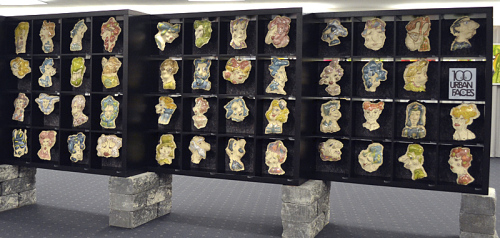+ Inspiration
Welch Schönheit und Ehrlichkeit versteckt sich in den Gesichtslinien des Stadtmenschen, wenn er sich von seinen vier Wänden geschützt fühlt!
+ Prozess
Es inspiriert mich, wie Gedanken und Gefühle an die Oberfläche von Gesichtern der Menschen dringen. Dieser Akt der Entdeckung von Authentizität ist etwas, das ich liebe. Sie fasziniert und bewegt mich zutiefst.
Meine 100 Urban Faces sind ein “Entdeckungsspiel”, bei dem ich herausfinde, wer sich hinter dem Gekritzel versteckt.
Wenn es mir gelingt, bin ich begeistert! In der Folge ergänze ich die Linien so, dass andere sehen können, was ich sehe. Die Plastizität des Tons bringt “Leben” in diese Linien und Gesichter. Dieses “Leben” zerleitet zum Angreifen, zündet Fantasie und erzeugt Emotionen: sei es Lachen, Mitgefühl, Spott, Freude und so weiter. Und dann, wenn ich solche spontanen Reaktionen an den Betrachtern erblicke, beginnt der Kreislauf wieder von vorne: Es inspiriert mich, wie Gedanken und Gefühle an die Oberfläche von Gesichtern…
+ Technik
Aus zufälligen Linien entstanden Zeichnungen, die in Ton geritzt und zu plastischen Gesichtern ausgeformt wurden.
Am Ende der Trocknungszeit sehe ich, dass manchmal das Kunststück sich in eine andere Richtung biegt und anders aussieht, wenn ich es mit den ersten Zeichnungen vergleiche. Ich mag es, dass Ton ein Gedächtnis hat, und ich lasse es einfach zu.
Danach kommt das Waschen, Färben und Glasieren.
Ich brenne die Werkstücke zwei bis drei mal bei bis zu 1060 °C.
+ Montage (anonym sein)
Das Stadtleben in vielen Städten dieses Planeten, bedeutet für viele das leben in kleinen Zimmern, in seriell gebauten Wohnhäusern. Und doch ist jede dieser kleinen Boxen groß in seiner Bedeutung als ZUHAUSE.
Ich fand in die IKEA Expedit Bücherregalen den Rahmen für die 100 Urban Faces. Sie sind serienmäßig gebaut und überall auf der Welt gleich. Wir passten die Regale an, indem wir kuschelige Divisionen (Kulissen) einbauten, so dass jedes “Gesicht” sein eigenes kleines Nest bekam.
Die Installation vereint die vielen “Individuen” und ist ein fester Bestandteil des Kunstwerks.



